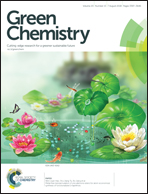Controllable exfoliation of natural silk fibers into nanofibrils by protein denaturant deep eutectic solvent: nanofibrous strategy for multifunctional membranes†
Abstract
Nanofibrils derived from diverse natural polymers have received extensive interest. However, the direct extraction of silk nanofibrils (SNFs), particularly individual nanofibrils, to preserve nanofibrous structures remains challenging due to the sophisticated hierarchical structure and high crystallinity of silk. Here, we report a facile, high-efficiency, and scalable liquid exfoliation method to directly extract SNFs with controllable diameters from ≈20 nm (individual SNFs) to 100 nm and contour lengths of 0.3–10 μm from silk fibers using protein denaturant deep eutectic solvent (PD-DES) urea/guanidine hydrochloride. Because the important fibrillar structure of natural silks was preserved, free-standing SNF membranes fabricated by using the vacuum filtration of SNF dispersions exhibited nanoporous structure, solvent insolubility, excellent mechanical properties, and thermal stability. An activated carbon-based solid-state supercapacitor fabricated with 18 μm-thick SNF membrane as a separator exhibited a high capacitance value of 171 F g−1 at 1 A g−1 with 86% capacitance retention as the current density increases to 10 A g−1. Moreover, SNF membranes showed size selectivity and adsorption performance for ions, dyes, and protein molecules when used as protein-based filtration membranes. SNF membranes with a unique structural features and reinforced properties have potential applications in energy storage devices and environmental engineering.



 Please wait while we load your content...
Please wait while we load your content...